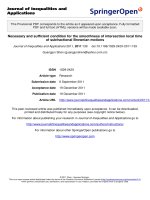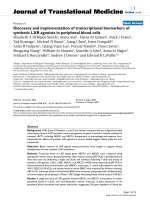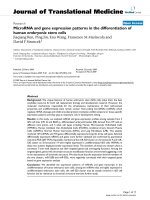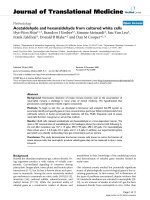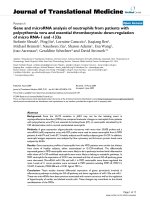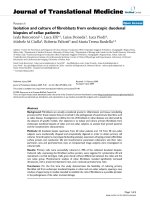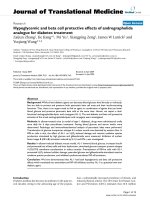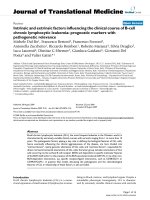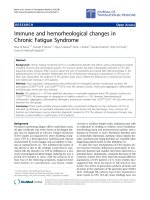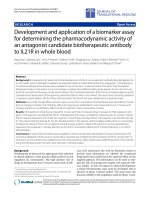báo cáo hóa học:" Fibrin and poly(lactic-co-glycolic acid) hybrid scaffold promotes early chondrogenesis of articular chondrocytes: an in vitro study" docx
Bạn đang xem bản rút gọn của tài liệu. Xem và tải ngay bản đầy đủ của tài liệu tại đây (1014.36 KB, 10 trang )
BioMed Central
Page 1 of 10
(page number not for citation purposes)
Journal of Orthopaedic Surgery and
Research
Open Access
Research article
Fibrin and poly(lactic-co-glycolic acid) hybrid scaffold promotes
early chondrogenesis of articular chondrocytes: an in vitro study
Munirah Sha'ban
1,2
, Soon Hee Kim
3
, Ruszymah BH Idrus
1,2
and
Gilson Khang*
3
Address:
1
Department of Physiology, Faculty of Medicine, Universiti Kebangsaan Malaysia, Jalan Raja Muda Abdul Aziz, 50300 Kuala Lumpur,
Malaysia,
2
Tissue Engineering Laboratory, Universiti Kebangsaan Malaysia Hospital, 9th floor, Clinical Block, Jalan Yaacob Latif, 56000 Cheras,
Kuala Lumpur, Malaysia and
3
BK-21 Polymer BIN Fusion Research Team, Department of Polymer Science and Technology, Chonbuk National
University, 664-14, Dukjin, Jeonju, 561-756, Seoul, Korea
Email: Munirah Sha'ban - ; Soon Hee Kim - ; Ruszymah BH Idrus - ;
Gilson Khang* -
* Corresponding author
Abstract
Background: Synthetic- and naturally derived- biodegradable polymers have been widely used to construct scaffolds for
cartilage tissue engineering. Poly(lactic-co-glycolic acid) (PLGA) are bioresorbable and biocompatible, rendering them as
a promising tool for clinical application. To minimize cells lost during the seeding procedure, we used the natural polymer
fibrin to immobilize cells and to provide homogenous cells distribution in PLGA scaffolds. We evaluated in vitro
chondrogenesis of rabbit articular chondrocytes in PLGA scaffolds using fibrin as cell transplantation matrix.
Methods: PLGA scaffolds were soaked in chondrocytes-fibrin suspension (1 × 10
6
cells/scaffold) and polymerized by
dropping thrombin-calcium chloride (CaCl
2
) solution. PLGA-seeded chondrocytes was used as control. All constructs
were cultured for a maximum of 21 days. Cell proliferation activity was measured at 1, 3, 7, 14 and 21 days in vitro using
3-(4,5-dimethylthiazole-2-yl)-2-, 5-diphenyltetrazolium-bromide (MTT) assay. Morphological observation, histology,
immunohistochemistry (IHC), gene expression and sulphated-glycosaminoglycan (sGAG) analyses were performed at
each time point of 1, 2 and 3 weeks to elucidate in vitro cartilage development and deposition of cartilage-specific
extracellular matrix (ECM).
Results: Cell proliferation activity was gradually increased from day-1 until day-14 and declined by day-21. A significant
cartilaginous tissue formation was detected as early as 2-week in fibrin/PLGA hybrid construct as confirmed by the
presence of cartilage-isolated cells and lacunae embedded within basophilic ECM. Cartilage formation was remarkably
evidenced after 3 weeks. Presence of cartilage-specific proteoglycan and glycosaminoglycan (GAG) in fibrin/PLGA hybrid
constructs were confirmed by positive Safranin O and Alcian Blue staining. Collagen type II exhibited intense
immunopositivity at the pericellular matrix. Chondrogenic properties were further demonstrated by the expression of
genes encoded for cartilage-specific markers, collagen type II and aggrecan core protein. Interestingly, suppression of
cartilage dedifferentiation marker; collagen type I was observed after 2 and 3 weeks of in vitro culture. The sulphated-
glycosaminoglycan (sGAG) production in fibrin/PLGA was significantly higher than in PLGA.
Conclusion: Fibrin/PLGA promotes early in vitro chondrogenesis of rabbit articular chondrocytes. This study suggests
that fibrin/PLGA may serve as a potential cell delivery vehicle and a structural basis for in vitro tissue-engineered articular
cartilage.
Published: 25 April 2008
Journal of Orthopaedic Surgery and Research 2008, 3:17 doi:10.1186/1749-799X-3-17
Received: 23 August 2007
Accepted: 25 April 2008
This article is available from: />© 2008 Sha'ban et al; licensee BioMed Central Ltd.
This is an Open Access article distributed under the terms of the Creative Commons Attribution License ( />),
which permits unrestricted use, distribution, and reproduction in any medium, provided the original work is properly cited.
Journal of Orthopaedic Surgery and Research 2008, 3:17 />Page 2 of 10
(page number not for citation purposes)
Background
Autologous chondrocytes implantation (ACI) was first
published by Brittberg et al. [1] in 1994. This technique is
quickly becoming a successful and viable alternative treat-
ment in orthopaedic surgery to total knee replacement,
arthroscopy, and abrasion therapy. Two-step procedures
are required for ACI. After cartilage is biopsied and cul-
tured, the next procedure is to implant cultured chondro-
cytes arthrotomically. The second procedure is invasive
and have all of the risks associated with open surgery.
Future improvements could be shifting the arthrotomy to
arthroscopic procedure to help decrease the morbidity
associated with arthrotomy. Therefore, we believed in vitro
generation of 3D cartilage construct can be utilized to
overcome the drawback. In recent years, several promising
recovery of small full thickness lesions using in vitro 3D
cartilage constructs have been discovered in rabbit [2-4],
goat [5,6], and dog [7]. We have successfully performed
autologous 'chondrocytes-fibrin' construct (ACFC)
implantation in sheep model [8-10] with good results.
However during implantation, we still performed arthrot-
omy and used periosteum to hold the implant since ACFC
was too soft to hold into defect independently. Therefore,
basic research is still necessary to develop its full potential.
Our next aim is to improve the scaffolding material of our
in vitro 3D cartilage construct.
Recently, various synthetic- and naturally-derived biode-
gradable polymers have been widely used to construct
scaffolds for tissue engineering purposes [11,12]. Many
trials have successfully cultured chondrocytes [13-15],
reconstructed tissue engineered cartilage [16-19] and
transplanted engineered cartilage into defect [3,8-10].
Thus, biocompatible scaffolds that afford cells prolifera-
tion and matrix accumulation have been widely investi-
gated [2,20,21]. Advantages of synthetically-derived
biodegradable polymers include controllable degradation
rate, high reproducibility, and easy to fabricate into spe-
cific shapes. Whilst naturally-derived biodegradable poly-
mers are usually mimicked the key elements of normal
tissue [22].
Poly(lactic-co-glycolic acid) (PLGA) are bioresorbable
and biocompatible synthetic polymer, rendering them as
a promising tool for regenerative medicine and clinical
application. Numerous attempts have been made for suc-
cessful tissue reconstruction using PLGA-based scaffold
either by PLGA itself [23,24] or in combination with nat-
ural polymers such as collagen [21,25], and extracellular
matrices scaffolds, i.e. small intestinal submucosa [26,27]
as well as demineralised bone particles [28]. Incorpora-
tion of bioactive molecules on PLGA surface is believed to
mediate cells behavior, e.g. proliferation, differentiation
and function [26-28]. To minimize cells lost during in
vitro seeding procedure, we used fibrin to immobilize cells
and to provide homogenous cells distribution in PLGA
scaffolds. Until this article is written, apart from similar
approach conducted by the research group from Germany
[29-31], there is limited information with regard to the
use of fibrin as a cell transplantation matrix for articular
chondrocyte in PLGA. Previously, the use of fibrin gel
immobilization technique resulted in homogeneous dis-
tribution and promoted bone formation of human peri-
osteum-derived progenitor cells in PLGA [29], PLGA-TCP
composites [30] and PLGA-polydioxanon fleeces [31].
Fibrin has also been used for cartilage reconstruction pur-
poses [8-10,13-20]. We hypothesized that fibrin would be
an ideal cell carrier/transplantation matrix and to enhance
in vitro chondrogenesis of rabbit articular chondrocytes by
mean of morphological, histological, biochemical and
phenotypically similar to the normal hyaline cartilage.
Methods
Harvest of cartilage, chondrocytes isolation and
monolayer culture expansion
Articular cartilage was aseptically dissected from the fem-
oral condyles and patellae of 6 weeks-old New Zealand
White rabbits (n = 6). Each sample was processed within
6 to 12 hours post-surgery. Cartilage was washed, minced
and digested with 0.6% collagenase A (Roche Applied Sci-
ence, Germany) at 37°C for 6 hours. Isolated chondro-
cytes were cultured at a density of 5,000 cells/cm
2
in F12
nutrient mixture (F12) and Dulbecco's Modified Eagle
Medium (DMEM) (Gibco, Grand Island, NY) supple-
mented with 10% foetal bovine serum (FBS) (Gibco) with
the presence of antibiotics and antimycotic (Gibco), 200
mM L-glutamine (Gibco) and 50 μg/ml of ascorbic acid
(Sigma). All cultures were maintained in 5% CO
2
incuba-
tor (Optima Model 560, Optima Inc, USA) at 37°C with
the medium changed every other day.
Preparation of microporous 3D PLGA scaffolds
PLGA copolymer (mole ratio 50:50, molecular weight
33,000 g/mole, Resomer RG 503 H) was purchased from
Boehringer Ingelheim Pharma GmbH (Ingelheim, Ger-
many). Micro-porous 3D PLGA scaffolds (0.2% w/v) were
fabricated by the solvent casting/salt leaching technique
using methylene chloride (CH
2
Cl
2
) (JT Baker, Baker Ana-
lyzed
®
A.C.S reagent, Malaysia) as previously described
[26,32]. Sieved sodium chloride (NaCl) particles (90 and
180 μm) were dispersed in a polymer/solvent solution,
which was then cast to make a scaffold using cylindrical
silicone moulds (7 mm in diameter and 3 mm thickness).
The salt particles were then leached out by continuous
soaking in deionized water for 48 hours. The scaffolds
were freeze-dried for 48 hours using freeze-dryer (IlShin
Lab Co. Ltd, South Korea).
Journal of Orthopaedic Surgery and Research 2008, 3:17 />Page 3 of 10
(page number not for citation purposes)
Formation of in vitro constructs
Each sample was assigned into two experimental groups –
chondrocytes were seeded into (1) PLGA scaffolds with
fibrin (fibrin/PLGA) and (2) PLGA without fibrin. Articu-
lar chondrocytes from primary passage (P0) were sub-cul-
tured (P1) in 75 cm
2
culture flasks (Falcon). After
confluence, cells were harvested, counted for total cell and
viability. PLGA scaffolds were sterilized upon use by 70%
ethanol. One million cells per scaffold was incorporated
and resuspended with (1) fibrin glue kit from Greenplast
®
(Green Cross P. D. Company, Yongin, Korea) and (2) cul-
ture medium. PLGA scaffolds were soaked in 'chondro-
cytes-fibrin' admixture and polymerized within 5 minutes
by dropping thrombin-CaCl
2
solution (Green Cross P. D.
Company, Yongin, Korea). Chondrocytes suspension in
culture medium was seeded directly into PLGA scaffolds.
All constructs were cultured for 21 days in vitro. All con-
structs were evaluated at each time point of 1-, 2- and 3-
weeks.
Measurement of cell proliferation activity of in vitro
constructs
Cell proliferation activity and cells viability was measured
using MTT assay at day 1, 3, 7, 14 and 21 in vitro. The tetra-
zolium compound MTT (0.5 mg/ml) (thiazolyl blue tetra-
zolium bromide, Sigma-Aldrich Inc., St Louis USA) was
added to all constructs and incubated for 4 hours at 37°C.
The resulted crystals were solubilised by dimethylsulfox-
ide (DMSO) (Sigma Chemical Co., St Louis, USA). The
absorbance was read using E-Max ELISA plate reader
(Molecular Device, USA) at 570 nm – yielding absorbance
as a function of viable cell number. Data was expressed as
mean ± standard error of the mean (SEM). Results were
analyzed using Student's t-test and the difference are con-
sidered significance when p < 0.05.
Macroscopic observation, histology and
immunohistochemistry analysis
Each construct was observed grossly at room temperature
without any fixation and palpated with forceps to assess
mechanical rigidity. After fixation with 10% formalin,
specimens were processed and stained with Haematoxylin
and Eosin (H&E) to assess tissue morphology, Safranin O
to identify presence of proteoglycan-rich matrix and
Alcian blue to detect accumulation of GAG. Immunohis-
tochemistry (IHC) analysis was performed in accordance
to the manufacturer's protocol (UltraTek HRP Kit, Immu-
notech, France) using monoclonal antibody (MAb)
mouse anti-rabbit collagen type II (Calbiochem
®
EMD
Biosciences, Inc. La Jolla) and MAb mouse anti-rabbit col-
lagen type I (Sigma Aldrich).
Total RNA isolation, cDNA synthesis and conventional
PCR
Total RNA was extracted from in vitro constructs at each
time point of 1, 2 and 3 weeks using TRIzol reagent (Inv-
itrogen, Carlsbad, CA) according to the manufacturer's
protocol. Reverse transcription was carried out using
Superscript™ II reverse transcriptase (Invitrogen, Carlsbad,
CA) according to the manufacturer's protocol under the
following conditions: 65°C for 5 minutes, 42°C for 2
minutes, 42°C and 70°C for 50 minutes and 15 minutes.
Polymerase chain reaction was carried out using the
Takara thermal cycler (Takara Bio Inc. Japan). Six-μl of the
amplified PCR products were separated by 1.5% agarose
gel electrophoresis (SeaKem
®
LE Agarose, Cambrex Bio
Science Rockland, Inc. USA), stained with SYBR
®
green
nucleic acid gel stain (Cambrex Bio Science Rockland, Inc.
USA) and visualized by UV transillumination using gel
documentation system EDAS 290 Kodak (Viber Lourmat,
France). All primer sequences were as follows: collagen
type II: forward: 5'-gcacccatggacattggaggg-3'/reverse: 5'-
atgttttaaaaaatacgaag-3' [33]. Aggrecan core protein: for-
ward: 5'-atcaacagagacctacgatgt-3'/reverse: 5'-gttagggtagag-
gtagaccgt-3' [34]. Collagen type I: forward: 5'-
gatgcgttccagttcgagta-3'/reverse: 5'-ggtcttccggtggtcttgta-3'
[33]. Rabbit β-actin gene [34] was used as an endogenous
control: forward: 5'-ccggcttcgcgggcgacg-3'/reverse: 5'-
tcccggccagccaggtcc-3'. All primers were prepared by Gen-
oTech. Corp. (Daejeon, Korea).
Sulphated glycosaminoglycan (sGAG) production assay
All samples were digested with papain digestion solution
(125 μg/mL of papain, 5 mM L-cystein, 100 mM
Na
2
HPO
4
, 5 mM EDTA, pH 6.8) at 60°C for 16 hours.
Sulphated GAG contents were analyzed using a 1,9-
dimethylmethylene blue (DMMB) assay [35]. Data was
expressed as mean ± standard error of the mean (SEM).
Results were analyzed using Student's t-test and the differ-
ence are considered significance when p < 0.05.
Results
Measurement of cell proliferation activity of in vitro
constructs
Fibrin/PLGA hybrid construct and the PLGA group exhib-
ited similar cell growth pattern in vitro (Figure 1). From
the chart, cells proliferation was gradually increased from
day-1 until day-7 with the fibrin/PLGA hybrid construct
showed significantly higher cells proliferation activity (p <
0.05) compared to PLGA at day-3. Next, by day-14, cell
proliferation activity in the fibrin/PLGA hybrid construct
and PLGA constructs was significantly increased by 2.13-
fold and 2.03-fold, respectively. However, the prolifera-
tion activity was then declined by day-21 in both groups.
It has been indicated that the early stage of chondrogene-
sis involves the activity to establish cell-to-cell communi-
cation and cell-to-matrix interaction with regards to new
Journal of Orthopaedic Surgery and Research 2008, 3:17 />Page 4 of 10
(page number not for citation purposes)
cartilaginous tissue formation. We presumed at this stage
the cellular proliferation has become less active. This
could be one possible explanation in relation to the signif-
icant reduction of cell proliferation in fibrin/PLGA hybrid
construct by 1.37-fold by the end of 21 days of in vitro cul-
ture.
Macroscopic observation of in vitro constructs
PLGA scaffold was designed in the shape of cylindrical
disc with 7 mm diameter × 3 mm height (Figure 2A). Scaf-
folds were prepared via solvent casting/salt leaching
method. This selective dissolution technique produced
highly porous polymer with pore sizes as same as the size
of sieved NaCl granules (90 and 180 μm). Morphological
appearance of in vitro fibrin/PLGA hybrid constructs (Fig-
ure 2B) and PLGA construct (Figure 2C) was similar by
day 7 in culture. However, at day 14, fibrin/PLGA hybrid
construct (Figure 2D) exhibited slightly smooth and glis-
tening morphology when compared to PLGA construct
(Figure 2E). Both constructs showed no resisting compres-
sion when palpated with forceps. By the end of the third
week, the in vitro fibrin/PLGA hybrid construct appeared
whiter, smoother and glistening (Figure 2F), resembling
morphology of cartilage-like tissue superior to PLGA con-
struct (Figure 2G). In addition, fibrin/PLGA hybrid con-
struct was slightly firmer than the PLGA construct.
Histological evaluation of in vitro constructs
At 2 weeks in vitro, when the fibrin/PLGA hybrid construct
were stained using H&E, they predominantly showed
superior histological features of normal cartilage com-
pared to the PLGA group. The closely-packed cartilage-iso-
lated cells were homogeneously distributed in the ECM
and exhibited rounded morphology with lacunae embed-
ded in basophilic ground substance (Figure 3A). The peri-
cellular and inter-territorial matrix region was strongly
stained by the characteristic red of Safranin O, indicating
presence of the proteoglycan-rich matrix (Figure 3B) cor-
roborated with positive Alcian Blue staining (Figure 3C)
confirming GAG accumulation. Next, the formation of
cartilaginous tissue was remarkably evident by the third
week of in vitro culture in the fibrin/PLGA hybrid con-
struct. Cartilage-isolated cells with lacunae was well-dis-
tributed within the homogenous ECM (Figure 3G) in
concert with the presence of specific histochemicals prop-
erty of proteoglycan-rich matrix (Figure 3H) and GAG
accumulation (Figure 3I). The difference between the
fibrin/PLGA hybrid construct (Figure 3A, B, C and Figure
3G, H, I) and PLGA group (Figure 3D, E, F and Figure 3J,
K, L) was clearly visible in term of overall cartilaginous tis-
sue formation, cells organization and ECM distribution in
all specimens. PLGA group exhibited few rounded
chondrocytes cluster filling up several void spaces of the
scaffold. For fibrin/PLGA hybrid construct, accumulation
of proteoglycan-rich matrix and GAG at the core region
was significant and was intensely stained at 2 weeks and
greatest at 3 weeks when compared to PLGA construct. No
sign of cartilaginous tissue formation in fibrin/PLGA
hybrid construct and PLGA construct was observed at one
week of in vitro culture.
Immunohistochemistry analysis of in vitro constructs
We analyzed collagen type II and collagen type I immu-
nolocalization on the fibrin/PLGA hybrid construct, and
we compared the results with the PLGA group. The spe-
cific cartilaginous ECM molecule, collagen type II exhib-
ited strong immunopositivity at the pericellular and the
inter-territorial matrix of the fibrin/PLGA hybrid con-
structs (Figure 4A). Minimal collagen type II expression
was observed in PLGA specimens (Figure 4C). After 3
weeks, as shown in Figure 4E collagen type II marker
maintained positive expression in the fibrin/PLGA hybrid
construct, as did the chondrocytes cluster in PLGA con-
struct (Figure 4G). Collagen type I expression demon-
strated moderate immunopositivity throughout the ECM
of both fibrin/PLGA hybrid constructs (Figure 4B, Figure
4F) and the PLGA group (Figure 4D, Figure 4H) at week 2
and week 3, respectively.
Cartilage-specific phenotypic expression analysis
When the mRNA expression of fibrin/PLGA hybrid con-
struct and PLGA group were compared, no significant dif-
ference was observed between chondrocytes derived from
both groups. The fibrin/PLGA hybrid construct and PLGA
group showed comparable potential in sustaining the spe-
cific chondrogenic phenotypic expression at each time
point of 1, 2 and 3 weeks. The expression of genes
encoded the cartilage-specific markers; collagen type II
and aggrecan core protein was steadily observed in in vitro
Measurement of cell proliferation activity of in vitro con-structsFigure 1
Measurement of cell proliferation activity of in vitro
constructs. Fibrin/PLGA and PLGA construct exhibited sim-
ilar growth pattern in vitro. Cells proliferation was gradually
increased until day-14. Fibrin/PLGA showed a significant
higher (p < 0.05) cells proliferation than PLGA at day-3 (*).
Cells proliferation activity had declined by day-21.
*
Journal of Orthopaedic Surgery and Research 2008, 3:17 />Page 5 of 10
(page number not for citation purposes)
Macroscopic observation of in vitro constructsFigure 2
Macroscopic observation of in vitro constructs. Figure 2A represents PLGA scaffold which was designed in the shape of
cylindrical disc. Fibrin/PLGA constructs (Figure 2B) and PLGA construct (Figure 2C) was morphologically similar after 7 days in
culture. Fibrin/PLGA construct (Figure 2D) showed slightly smooth and glistening morphology when compared to PLGA (Fig-
ure 2E) after 14 days. By week 3, fibrin/PLGA construct appeared whiter, smoother and glistening (Figure 2F) than PLGA (Fig-
ure 2G).
PLGA scaffold Æ
ÆÆ
Æ
A
Fibrin/PLGA PLGA
1 week Æ
ÆÆ
Æ
B
C
2 weeks Æ
ÆÆ
Æ
D
E
3 weeks Æ
ÆÆ
Æ
F
G
Journal of Orthopaedic Surgery and Research 2008, 3:17 />Page 6 of 10
(page number not for citation purposes)
culture, whereas collagen type I, the cartilage dedifferenti-
ation marker exhibited down-regulation pattern after 2
and 3 weeks in vitro. The house-keeping gene, β-actin was
steadily expressed in all specimens; to verify the two-step
reverse-transcriptase PCR analysis was reliable and suc-
cessful. Results were summarized in Figure 5.
Sulphated glycosaminoglycan (sGAG) production assay
The increment of average wet weight of fibrin/PLGA
hybrid constructs (116.27 ± 4.65 mg, 137.25 ± 6.08 mg,
162.69 ± 7.12 mg) and PLGA group (116.88 ± 1.98 mg,
172.20 ± 8.78 mg, 241.33 ± 9.82 mg) was statistically sig-
nificant (p < 0.05) from week 1, week 2 and week 3,
respectively. After 2 and 3 weeks of in vitro culture, the
PLGA group demonstrated significantly higher wet weight
(p < 0.05) than fibrin/PLGA hybrid constructs by 1.25-
fold and 1.48-fold, respectively (Figure 6A). As shown in
Figure 6B, sGAG production in the fibrin/PLGA hybrid
construct was definitely superior to the PLGA group at
each time point. Normalized by the dried-weight of each
sample, the relative sGAG content (%) was significantly
higher (p < 0.05) in fibrin/PLGA hybrid constructs com-
pared to the PLGA group at 1 week and 3 week cultures. In
particular, at week 1, with 0.223 ± 0.010 relative sGAG
content, fibrin/PLGA hybrid constructs exhibited 1.92-
fold higher sGAG production than the PLGA group; 0.116
± 0.025. At week 2, the relative sGAG content in fibrin/
PLGA hybrid constructs; 0.197 ± 0.037 seemed higher
than 0.113 ± 0.042, the relative sGAG content in PLGA
group; however the magnitude showed no significance
difference between both groups. Next, by week 3, fibrin/
PLGA hybrid constructs exhibited 0.296 ± 0.011 relative
sGAG content, which was 1.67-fold higher than 0.177 ±
0.027 relative sGAG content in the PLGA group.
Discussion
Our aimed was to evaluate in vitro chondrogenesis of rab-
bit articular chondrocytes in PLGA scaffold utilizing fibrin
as a cell transplantation matrix. Fibrin is biodegradable,
biocompatible and non-immunogenic natural material
[36], thus rendering this material as suitable scaffolding
cell carriers [20] that helps provide homogenous cells dis-
tribution with no significant cells lost during the seeding
process [29-31]. Immobilization of chondrocytes in fibrin
Histological evaluation of in vitro constructsFigure 3
Histological evaluation of in vitro constructs. Fibrin/PLGA constructs showed superior histological features of cartilage-
like tissue compared to PLGA. Differences between fibrin/PLGA (Figure 3A, B, C and Figure 3G, H, I) and PLGA (Figure 3D, E,
F and Figure 3J, K, L) were clearly visible in term of overall cartilaginous tissue formation, cells organization and ECM distribu-
tion. The fibrin/PLGA constructs was intensely stained with Safranin O for accumulated proteoglycan and Alcian Blue for GAG
at 2 weeks and greatest at 3 weeks.
Journal of Orthopaedic Surgery and Research 2008, 3:17 />Page 7 of 10
(page number not for citation purposes)
Immunohistochemistry analysis of in vitro constructsFigure 4
Immunohistochemistry analysis of in vitro constructs. As shown in Figure 4A, fibrin/PLGA exhibited strong immunopo-
sitivity of collagen type II which mainly localized at the pericellular and inter-territorial matrix. Minimal collagen type II expres-
sion could be observed in the PLGA construct (Figure 4C). After 3 weeks, collagen type II expression was maintained in fibrin/
PLGA (Figure 4E) and PLGA (Figure G). Collagen type I in fibrin/PLGA constructs showed moderate immunopositivity at
week-2 (Figure 4B) and week-3 (Figure 4F), as did PLGA (Figure 4D, Figure 4H).
Collagen type II x400 Collagen type I x400
Fibrin/ PLGA
A
B
Week 2
PLGA
C
D
Fibrin/ PLGA
E
F
Week 3
PLGA
G
H
Journal of Orthopaedic Surgery and Research 2008, 3:17 />Page 8 of 10
(page number not for citation purposes)
resulted in homogenous cells distribution in PLGA scaf-
folds, easy to handle and deliver the cells [37]. Similar
finding was reported in the previous assessment of osteo-
genic potential utilizing human periosteum-derived pro-
genitor cells and fibrin gel immobilization technique in
PLGA scaffold [29-31]. With regards to the present study,
Lee et al. [37] also reported fibrin provided more uniform
chondrocytes distribution during cell seeding via histol-
ogy in macro-porous polyurethane scaffold.
Recently, Endres et al. [38] showed the 3D arrangement of
human articular chondrocytes in human fibrin glue and
resorbable PGA scaffolds cultured in the presence of
human serum is an excellent system for the maturation of
cartilage grafts in articular cartilage regeneration. It has
been well documented that during growth in monolayer
culture, chondrocytes adopt many of the phenotypic traits
of fibroblast, as they become elongated and synthesize
type I collagen rather than type II collagen. Thus, to
induce the re-differentiation of expanded chondrocytes,
the cells were first combined with fibrin glue as a tempo-
rary matrix and embedded in a resorbable felt structure to
achieve a three-dimensional environment [38]. In this
study, following cells seeding onto scaffolds, cells prolif-
erated markedly in fibrin/PLGA and PLGA. Because of the
growth, chondrocytes can secrete appropriate ECM mole-
cules and develop chondrocyte-chondrocyte interaction
to form clusters of various sizes as well as the 3D structure
while preserving the original shape of the cell. By 2 weeks
of culture period, histological differences between fibrin/
PLGA and PLGA were obviously developed. Newly
formed ECM was concentrated around the rounded cells,
consistent with the established notion that a rounded
morphology is an obligatory for the chondrocytic pheno-
type. Besides the histologically mature chondrocyte,
extensive development of ECM indicated by presences of
abundant proteoglycan-rich matrix and accumulated
GAG in fibrin/PLGA was better than in PLGA. The expres-
sion of collagen type II, cartilage-specific ECM molecule
was noticeably superior in fibrin/PLGA compared to
PLGA. By day 21, fibrin/PLGA had significant cells-matrix
organization and ECM deposition compared to PLGA
group. Decline in growth rate by 21 days can be explained
by a morphologically and structurally stable cells-matrix
organization entering a steady state with no active cellular
function at this stage. Clearly, the ECM production on
fibrin/PLGA was superior to that of PLGA group. Lee et al.
[37] suggested that the phenomenon may be due to
higher cell-seeding efficiency and more homogeneous dis-
Sulphated-glycosaminoglycan (sGAG) production assayFigure 6
Sulphated-glycosaminoglycan (sGAG) production
assay. The wet weight (Figure 6A) and sGAG production
(Figure 6B) of the in vitro constructs were measured at 1, 2,
and 3 weeks of culture, respectively. After 2 and 3 weeks in
vitro, PLGA demonstrated significantly higher wet weight (p <
0.05) compared to fibrin/PLGA. The sGAG production in
fibrin/PLGA construct was superior to PLGA. Relative sGAG
contents (%) were significantly higher (p < 0.05) in fibrin/
PLGA than PLGA at 1 week and 3 weeks.
A
*
*
B
*
*
*
Cartilage-specific phenotypic expression analysisFigure 5
Cartilage-specific phenotypic expression analysis. The
expression of genes encoded the cartilage-specific markers;
collagen type II and aggrecan core protein was steadily
expressed in fibrin/PLGA and PLGA. Interestingly, suppres-
sion of collagen type I was observed in fibrin/PLGA and
PLGA at 2 weeks and 3 weeks. β-actin gene was steadily
expressed in all samples to verify the analysis was reliable and
successful.
PLG
A
Fibrin/PLG
A
Genes
PCR product
Week Æ
ÆÆ
Æ 1 2 3 1 2 3
(A) ß-actin:
227 bp
Æ
ÆÆ
Æ
(B) Collagen type II:
394 bp
Æ
ÆÆ
Æ
(C) Aggrecan core
protein:
289 bp
Æ
ÆÆ
Æ
(D) Collagen type I:
312 bp
Æ
ÆÆ
Æ
Journal of Orthopaedic Surgery and Research 2008, 3:17 />Page 9 of 10
(page number not for citation purposes)
tribution of chondrocytes in the fibrin/PLGA hybrid con-
struct. Similar criterion could be observed in PLGA-
incorporated with collagen micro-sponges which was pre-
viously encountered as a promising 3D scaffold for artic-
ular cartilage tissue engineering [21,25].
Although there were remarkable histological differences
in fibrin/PLGA hybrid scaffold and PLGA group, there was
no significant variation in the semi-quantitative gene
expression assessment for collagen type II, aggrecan core
protein and collagen type I. Gene expression profiles
showed that the chondrocyte phenotype was maintained
in both groups. Interestingly, suppression of cartilage ded-
ifferentiation marker, collagen type I can be observed in
the in vitro constructs. Previously, although Lee et al. [37]
reported the fibrin hydrogel-polyurethane hybrid scaffold
system promoted higher levels of cartilage gene expres-
sion in the early stage of culture, the system still did not
permit maintenance of the chondrocyte phenotype for the
entire 4-week culture period. Accordingly, we suggest that
fibrin would be an ideal cell carrier/transplantation
matrix and enhance in vitro chondrogenesis of rabbit artic-
ular chondrocytes by mean of morphological, histologi-
cal, biochemical and phenotypically similar to the normal
hyaline cartilage. If this result is applicable for the clinical
use, it is practically reliable for the reconstruction of clin-
ical transplants for future orthopaedic surgery.
Conclusion
Fibrin/PLGA hybrid scaffold promotes early in vitro chon-
drogenesis of rabbit articular chondrocytes proven by
means of morphology, histology, immunohistochemis-
try, chondrogenic gene expression and sGAG production.
This study suggests that fibrin/PLGA hybrid scaffold may
serve as a potential cell delivery vehicle and a structural
basis for in vitro tissue-engineered articular cartilage con-
struct. The in vivo experiment has been carried out and the
results are currently written as a next chapter for this
study.
Competing interests
The authors declare that they have no competing interests.
Authors' contributions
MS conceived the study, participated in its design, per-
formed all the experiments and drafted the manuscript.
SHK participated in the design of the study and conceived
of the study. RBHI participated in the design of the study
and conceived of the study. GK participated in the design
of the study, conceived the study and drafted the manu-
script. All authors read and approved the final manu-
script.
Acknowledgements
This study was made possible by SCRC (SC3100) and KMOHW (0405-
BO01-0204-0006). We thank Ms Youn Kyung Ko, Ms Hyun Jung Ha, Ms
Jung Won So and the BK-21 Polymer BIN Fusion Research Team, Depart-
ment of Polymer Science and Technology, Chonbuk National University,
South Korea who provided technical help for this study.
References
1. Brittberg M, Lindahl A, Nilsson A, Ohlsson C, Isaksson O, Peterson
L: Treatment of deep cartilage defects in the knee with autol-
ogous chondrocyte transplantation. N Engl J Med 1994,
331(14):889-95.
2. Shao XX, Hutmacher DW, Ho ST, Goh JCH, Lee EH: Evaluation of
a hybrid scaffold/cell construct repair of high load bearing
osteochondral defects in rabbits. Biomaterials 2006, 27:1071-80.
3. Willers C, Chen J, Wood D, Xu J, Zheng MH: Autologous
chondrocytes implantation with collagen bioscaffold for the
treatment of osteochondral defects in rabbits. Tissue Eng
2005, 11(7/8):1065-76.
4. Ito Y, Ochi M, Adachi N, Sugawara K, Yanada S, Ikada Y, Ronakorn P:
Repair of osteochondral defect with tissue engineered chon-
dral plug in rabbit model. Arthroscopy 2005, 21(10):1155-63.
5. Niederauer GG, Silva MA, Leatherbury NC, Korvick DL, Harroff HH,
Ehler WC, Dunn CJ, Kiewsetter K: Evaluation of multiphase
implants for repair of focal osteochondral defects in goats.
Biomaterials 2000, 21:2561-74.
6. van Susante JLC, Buma P, Schuman L, Homminga GN, Berg WB van
den, Veth RPH: Resurfacing potential of heterologous
chondrocytes suspended in fibrin glue in large full-thickness
defects of femoral articular cartilage: an experimental study
in the goat. Biomaterials 1999, 20:1167-75.
7. Breinan HA, Minas T, Hsu HP, Nehrer S, Shortkroft S, Spector M:
Autologous chondrocytes implantation in a canine model:
change in composition of reparative tissue with time. J Orthop
Res 2001, 19:482-492.
8. Munirah S, Samsudin OC, Chen HC, Hussein SSS, Mohd Azam Khan
GK, Aminuddin BS, Ruszymah BHI: Articular cartilage restora-
tion in load-bearing osteochondral defects by autologous
chondrocytes-fibrin constructs implantation: an experimen-
tal study in sheep. J Bone Joint Surg (Br) 2007, 89-B:1099-1109.
9. Munirah S, Samsudin OC, Loqman MY, Siti Norhayati I, Chua KH,
Aminuddin BS, Ruszymah BHI: The potential of autologous car-
tilage implantation in ovine focal cartilage defects: a new
option for articular cartilage restoration [Abstract]. Tissue
Eng 2006, 12(4):
1014.
10. Ruszymah BHI, Samsudin OC, Munirah S, Chen HC, Sharifah Salmah
SH, Mohd Azam SGK, Aminuddin BS: Repair of articular cartilage
after implantation with autologous engineered cartilage
made using autologous fibrin as the biomaterial: A fully
autologous system [Abstract]. In World Congress on Tissue Engi-
neering & Regenerative Medicine Pittsburgh, Pennsylvania Poster;
2006:268.
11. Kim SH, Ha HJ, Ko YK, Yoon SJ, Rhee JM, Kim MS, Lee HB, Khang G:
Correlation of proliferation, morphology and biological
responses of fibroblasts on LDPE with different surface wet-
tability. J Biomater Sci Polym Ed 2007, 18(5):609-622.
12. Ko YK, Kim SH, Ha HJ, Yoon SJ, Rhee JM, Kim MS, Lee HB, Khang G:
Hybrid type of tissue-engineered biodisc using annulus fibro-
sus seeded PLGA scaffold and nucleus pulposus seeded
MPEG-PCL hydrogel: Preliminary study. Key Engineering Mater
2007, 342–343:173-176.
13. Munirah S, Aminuddin BS, Samsudin OC, Badrul AHMY, Azmi B,
Ruszymah BHI: The significance of autologous human serum
versus pooled human serum supplementation for the
growth of human articular chondrocytes. J Orthop Surg (Hong
Kong) in press.
14. Munirah S, Aminuddin BS, Samsuddin OC, Chua KH, Fuzina NH,
Ruszymah BHI: The re-expression of collagen type II, aggrecan
and Sox9 in tissue engineered human articular cartilage. Tis-
sue Eng Regen Med 2005, 2:347-55.
15. Munirah S, Aminuddin BS, Chua KH, Fuzina NH, Isa MR, Ruszymah
BHI: Tissue engineered human articular neocartilage using
serial expanded chondrocytes. Med J Malaysia 2004, 59(Suppl
B):9-10.
16. Samsudin OC, Aminuddin BS, Munirah S, Chua KH, Fuzina NH, Isa
MR, Azmi B, Badrul AHMY, Ruszymah BHI: In vitro development
of autologous tissue engineered human articular neocarti-
Publish with BioMed Central and every
scientist can read your work free of charge
"BioMed Central will be the most significant development for
disseminating the results of biomedical research in our lifetime."
Sir Paul Nurse, Cancer Research UK
Your research papers will be:
available free of charge to the entire biomedical community
peer reviewed and published immediately upon acceptance
cited in PubMed and archived on PubMed Central
yours — you keep the copyright
Submit your manuscript here:
/>BioMedcentral
Journal of Orthopaedic Surgery and Research 2008, 3:17 />Page 10 of 10
(page number not for citation purposes)
lage for orthopaedic surgery. Med J Malaysia 2004, 59(Suppl
B):15-16.
17. Badrul AHMY, Aminuddin BS, Sharaf I, Samsudin OC, Munirah S,
Ruszymah BHI: The Effects of autologous human serum on the
growth of tissue engineered human articular cartilage. Med
J Malaysia 2004, 59(Suppl B):11-12.
18. Azmi B, Aminuddin BS, Sharaf I, Samsudin OC, Munirah S, Chua KH,
Ruszymah BHI: The significance of using pooled human serum
in human articular cartilage tissue engineering. Med J Malaysia
2004, 59(Suppl B):13-14.
19. Munirah S, Aminuddin BS, Chua KH, Samsudin OC, Badrul AHMY,
Azmi B, Fuzina NH, Ruszymah BHI: Tissue-engineered human
articular cartilage demonstrates intense immunopositivity
for collagen type II. J Biosciences 2006, 17(1):9-18.
20. Eyrich D, Brandl F, Appel B, Wiese H, Maier G, Wenzel M, Stauden-
maier R, Goepferich A, Blunk T: Long-term stable fibrin gels for
cartilage engineering. Biomaterials 2007, 28:55-65.
21. Chen G, Tanaka J, Tateishi T: Osteochondral tissue engineering
using a PLGA-collagen hybrid mesh. Materials Science and Engi-
neering C 2006, 26:124-129.
22. Khang G, Kim MS, Cho SH, Lee I, Rhee JM, Lee HB: Natural scaf-
folds biomaterials for tissue regeneration. Tissue Eng Regen
Med 2004, 1(1):9-20.
23. Park GE, Pattison MA, Park K, Webster TJ: Accelerated chondro-
cyte functions on NaOH-treated PLGA scaffolds. Biomaterials
2005, 26(16):3075-3082.
24. Park GE, Park K, Webster TJ: NaOH-treated PLGA scaffolds
allow for greater articular chondrocyte functions. Bioengineer-
ing Conference. Proceedings of the IEEE 30th Annual Northeast
2004:148-149 [ />01300038.pdf?tp=&isnumber=&arnumber=1300038]. Accessed
online 25
th
July 2007
25. Chen G, Sato T, Ushida T, Ochiai N, Tateishi T: Tissue engineering
of cartilage using a hybrid scaffold of synthetic polymer and
collagen. Tissue Eng 2004, 10(3/4):323-330.
26. Kim SH, Yoon SJ, Choi B, Ha HJ, Rhee JM, Kim MS, Yang YS, Lee HB,
Khang G: Evaluation of various types of scaffold for tissue
engineered intervertebral disc. Adv Exp Med Biol 2006,
585:169-181.
27. Lee SJ, Lee I, Lee YM, Lee HB, Khang G: Macroporous biodegrad-
able natural/synthetic hybrid scaffolds as small intestine
mucosa impregnated poly(lactide0 co- glycolide) for tissue
engineered bone. J Biomater Sci Polym Ed 2004, 15(8):1003-1017.
28. Jang JW, Park KS, Kim SH, Park CS, Kim MS, Han CW, Rhee JM,
Khang G, Lee HB: Tissue engineered bone regeneration using
DBP-loaded PLGA scaffold in rabbit model. Tissue Eng Regen
Med 2005, 2(1):34-40.
29. Zheng YX, Ringe J, Liang Z, Loch A, Chen L, Sittinger M: Osteogenic
potential of human periosteum-derived progenitor cells in
PLGA scaffold using allogeneic serum. J Zhejiang Univ Sci B 2006,
7(10):817-824.
30. Arnold U, Lindenhayn K, Perka C: In vitro-cultivation of human
periosteum derived cells in bioresorbable polymer-TCP-
composites. Biomaterials 2002, 23(11):2303-2310.
31. Perka C, Schultz O, Spitzer RS, Lindenhayn K, Burmester GR, Sit-
tinger M: Segmental bone repair by tissue-engineered perio-
steal cell transplants with bioresorbable fleece and fibrin
scaffolds in rabbits. Biomaterials 2000, 21(11):1145-1153.
32. Khang G, Lee SJ, Han CW, Rhee JM, Lee HB: Preparation and
characterization of natural/synthetic hybrid scaffolds. Adv Exp
Med Biol 2003, 657:235-245.
33. Ha HJ, Kim SH, Yoon SJ, Ko YK, Lee EK, Son Y, Kim MS, Rhee JM,
Khang G, Lee BH: Characterization of annulus fibrosus and
nucleus pulposus with sequential passage. Tissue Eng Regen Med
2006, 3(4):416-422.
34. Yamazaki S, Banes AJ, Weinhold PS, Tsuzaki M, Kawakami M,
Minchew JT: Vibratory loading decreases extracellular matrix
and matrix metalloproteinase gene expression in rabbit
annulus cells: one hundred sixty years ago in spine. Spine J
2002, 2(6):415-420.
35. Whitley CB, Ridnour MD, Draper KA, Dutton CM, Neglia JP: Diag-
nostic test for mucopolysaccharidosis I. Direct method for
quantifying excessive urinary glycosaminoglycan excretion.
Clin Chem 1989, 35:374-9.
36. Ruszymah BHI: Autologous human fibrin as the biomaterial for
tissue engineering. Med J Malaysia 2004, 59(Suppl B):30.
37. Lee CR, Grad S, Gorna K, Gogolewski S, Goessl A, Alini M: Fibrin-
polyurethane composites for articular cartilage tissue engi-
neering: A preliminary analysis. Tissue Eng 2005, 11(9/
10):1562-157.
38. Endres M, Neumann K, Schroder SEA, Vetterlein S, Morawietz L,
Ringe J, Sittinger M, Kaps C: Human polymer-based cartilage
grafts for the regeneration of articular cartilage defects. Tis-
sue Cell 2007, 39(5):293-301.
